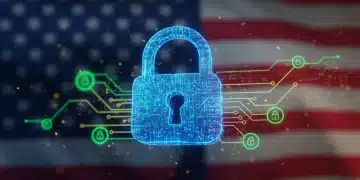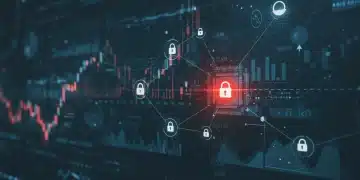Zero Trust Architecture: Implementing in Your Organization in 2025

Zero Trust Architecture (ZTA) represents a paradigm shift in cybersecurity, moving away from traditional perimeter-based security to a model where trust is never assumed and is continuously verified, providing a more robust defense against increasingly sophisticated cyber threats when implemented in an organization in 2025.
As cyber threats continue to evolve in complexity and frequency, organizations are increasingly recognizing the limitations of traditional perimeter-based security models, so the Zero Trust Architecture: A Practical Guide to Implementing It in Your Organization in 2025 could be a key strategy for organizations.
Understanding Zero Trust Architecture
Zero Trust Architecture (ZTA) is not a single product but a strategic approach to cybersecurity that fundamentally shifts how organizations secure their digital assets, moving away from the outdated concept of ‘trust but verify’ to a ‘never trust, always verify’ model.
This approach assumes that threats are present both inside and outside the traditional network perimeter, requiring strict identity verification for every person and device trying to access resources on the network, regardless of their location.
Core Principles of Zero Trust
Understanding the core principles is crucial for successful implementation because they dictate how security measures should be configured and managed. Each principle contributes to a more secure and resilient network.
- Never Trust, Always Verify: Every user, device, and application must be authenticated and authorized before gaining access to network resources, regardless of their location or status.
- Assume Breach: Act as if the network has already been breached, and design security measures to limit the impact of potential breaches.
- Least Privilege Access: Grant users and devices only the minimum level of access required to perform their duties, reducing the attack surface and preventing lateral movement.
- Microsegmentation: Divide the network into smaller, isolated segments to prevent attackers from moving freely throughout the network in the event of a breach.
By adhering to these principles, organizations can significantly reduce their risk of cyberattacks and data breaches, ensuring a more secure and resilient digital environment.
Assessing Your Organization’s Readiness for Zero Trust
Before diving into Zero Trust implementation, it’s critical to evaluate your organization’s existing infrastructure, policies, and security posture, which allows you to identify gaps and tailor your Zero Trust strategy accordingly.
This assessment should involve not only the IT department but also stakeholders from other departments such as HR, finance, and operations, ensuring a comprehensive understanding of the organization’s security needs.

Key Steps in Assessing Readiness
A detailed readiness assessment involves several key steps, each designed to provide valuable insights into the organization’s current security landscape.
- Identify Critical Assets: Determine which data, applications, and systems are most critical to the organization’s operations and require the highest level of protection.
- Evaluate Existing Security Policies: Review current security policies and procedures to identify gaps and areas that need improvement to align with Zero Trust principles.
- Assess Network Infrastructure: Evaluate the current network architecture, including hardware, software, and security devices, to determine its ability to support Zero Trust implementation.
- Analyze Current Threats: Understand the types of threats the organization is currently facing and how Zero Trust can help mitigate those risks.
By completing these steps, organizations can develop a clear roadmap for implementing Zero Trust, focusing on the areas that will provide the greatest security benefits.
Building a Zero Trust Implementation Roadmap
A well-defined roadmap is essential for successful implementation because it provides a clear path forward, outlining the steps needed to achieve a Zero Trust environment.
This roadmap should include specific goals, timelines, and resource allocations, ensuring that the implementation stays on track and delivers the desired security outcomes.
Phases of a Zero Trust Roadmap
A Zero Trust implementation roadmap typically consists of several phases, each focusing on specific aspects of the implementation, contributing to a structured and manageable process.
- Planning and Design: Define the scope of the implementation, identify key stakeholders, and develop a detailed plan outlining the steps, timelines, and resources needed.
- Implementation: Deploy the necessary security tools and technologies, such as multi-factor authentication, microsegmentation, and identity management systems, following the plan established in the planning phase.
- Testing and Validation: Conduct thorough testing to ensure that the implemented security measures are functioning correctly and providing the desired level of protection.
- Monitoring and Optimization: Continuously monitor the Zero Trust environment to identify potential issues and optimize security measures to maintain a strong security posture as threats evolve.
Each phase should be approached with careful planning and execution, ensuring that the implementation aligns with the organization’s overall security goals and objectives.
Implementing Microsegmentation in a Zero Trust Environment
Microsegmentation is a critical component of Zero Trust, involving the division of the network into isolated segments to limit the impact of potential breaches.
By creating these smaller, more manageable segments, organizations can prevent attackers from moving laterally across the network, containing the breach to a single segment.
Benefits of Microsegmentation
Microsegmentation offers several key benefits that enhance the overall security posture of an organization. Implementing microsegmentation can significantly improve network security.
- Reduced Attack Surface: By isolating network segments, the attack surface is reduced, making it more difficult for attackers to gain access to critical resources.
- Improved Breach Containment: In the event of a breach, microsegmentation limits the attacker’s ability to move laterally across the network, reducing the impact of the breach.
- Enhanced Visibility: Microsegmentation provides greater visibility into network traffic and user activity, allowing security teams to quickly detect and respond to suspicious behavior.
- Simplified Compliance: By isolating sensitive data and systems, microsegmentation can simplify compliance with regulatory requirements, such as GDPR and HIPAA.

Implementing microsegmentation requires careful planning and configuration, including defining access policies, configuring firewalls, and monitoring network traffic, but the benefits are well worth the effort.
The Role of Identity and Access Management (IAM)
Identity and Access Management (IAM) plays a central role in Zero Trust by ensuring that only authorized users and devices have access to network resources.
IAM involves implementing strong authentication methods, such as multi-factor authentication (MFA), and enforcing strict access controls based on the principle of least privilege.
Key IAM Components for Zero Trust
Several key IAM components are essential for implementing Zero Trust, each providing specific capabilities that enhance the overall security posture. These components work together to ensure secure access to network resources.
- Multi-Factor Authentication (MFA): Requires users to provide multiple forms of authentication, such as a password and a one-time code, before granting access to network resources.
- Role-Based Access Control (RBAC): Assigns access privileges based on users’ roles within the organization, ensuring that they only have access to the resources needed to perform their duties.
- Privileged Access Management (PAM): Provides enhanced security controls for privileged accounts, such as administrators, to prevent unauthorized access and misuse.
- Identity Governance and Administration (IGA): Automates the process of managing user identities and access rights, ensuring that access is properly provisioned, monitored, and revoked when necessary.
By implementing these IAM components, organizations can significantly reduce their risk of unauthorized access and data breaches, ensuring a more secure and compliant environment.
Monitoring and Automation in a Zero Trust Environment
Continuous monitoring and automation are essential for the ongoing success of Zero Trust, allowing organizations to detect and respond to threats in real-time.
By leveraging security information and event management (SIEM) systems and security orchestration, automation, and response (SOAR) tools, organizations can automate security tasks and improve their overall security posture.
Strategies for Effective Monitoring and Automation
Effective monitoring and automation involve several key strategies, each designed to enhance the organization’s ability to detect and respond to threats quickly and effectively. By implementing these strategies, organizations can maintain a strong security posture.
- Real-Time Threat Detection: Implement SIEM systems to collect and analyze security logs from various sources, enabling real-time detection of suspicious activity.
- Automated Incident Response: Use SOAR tools to automate incident response processes, such as isolating compromised systems and blocking malicious traffic.
- Continuous Vulnerability Scanning: Regularly scan the network for vulnerabilities and misconfigurations, automatically prioritizing and remediating critical issues.
- User and Entity Behavior Analytics (UEBA): Implement UEBA tools to monitor user and device behavior, detecting anomalies that may indicate insider threats or compromised accounts.
By embracing monitoring and automation, organizations can maintain a proactive security posture, staying one step ahead of potential threats and minimizing the impact of security incidents.
| Key Aspect | Brief Description |
|---|---|
| 🔑 Core Principle | Never trust, always verify every user, device, and application. |
| 🛡 Microsegmentation | Divide the network into segments to reduce the attack surface. |
| 👤 IAM | Manage identities and control access based on roles. |
| 🤖 Monitoring & Automation | Continuously monitor and automate responses to threats. |
Frequently Asked Questions (FAQ)
▼
Zero Trust Architecture (ZTA) is a security model that assumes no user or device is trustworthy by default. All access requests are fully authenticated, authorized, and encrypted before granting access.
▼
In 2025, with growing cyber threats and remote work, Zero Trust is important because it ensures continuous verification and least privilege access, reducing the risk of data breaches and enhancing security.
▼
To assess Zero Trust readiness, identify critical assets, evaluate existing security policies, assess your network infrastructure, and analyze current threats to understand your current security posture.
▼
Key steps include planning and design, implementation of security tools like MFA and microsegmentation, testing and validation of security measures, and continuous monitoring and optimization for threat detection.
▼
IAM ensures only authorized users and devices access resources. It uses MFA, RBAC, and PAM to enforce strict access controls based on need, improving overall security for Zero Trust environments.
Conclusion
Implementing Zero Trust Architecture is a strategic move for any organization looking to bolster its cybersecurity defenses in 2025. By embracing the principles of ‘never trust, always verify,’ organizations can create a more secure and resilient environment, protecting their critical assets from increasingly sophisticated cyber threats.





